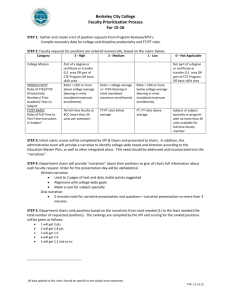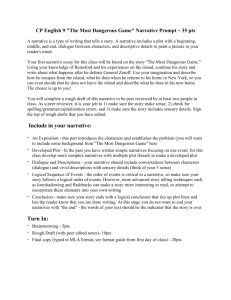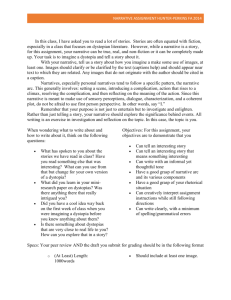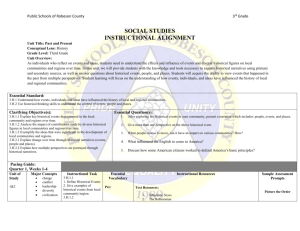Narrative Strategies
advertisement
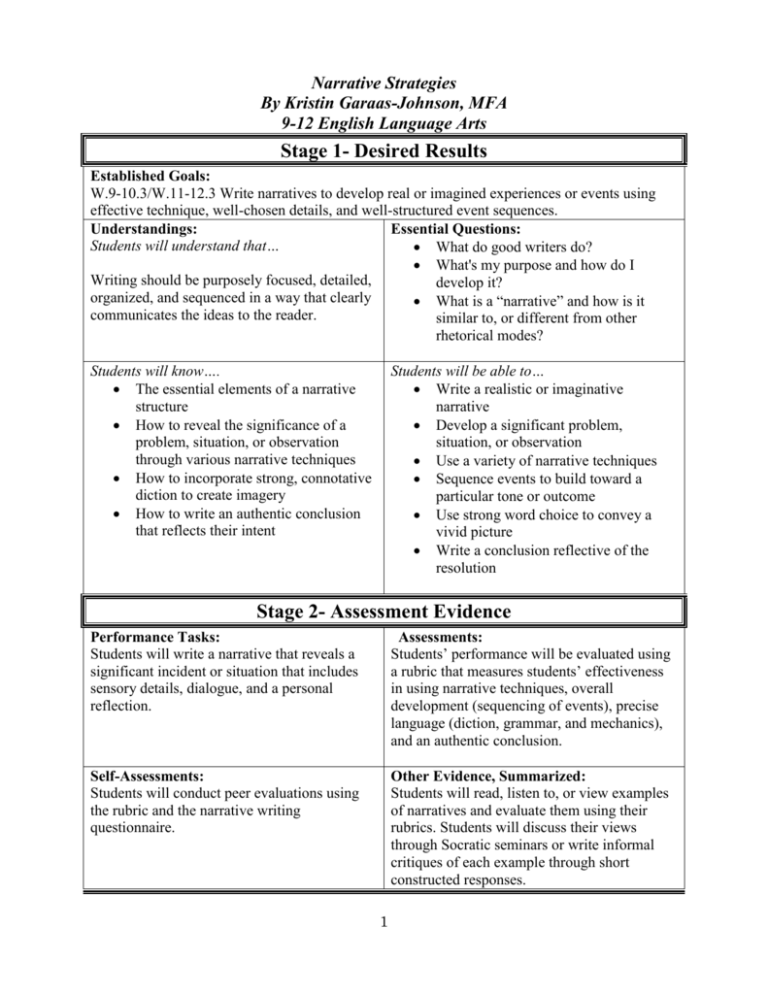
Narrative Strategies By Kristin Garaas-Johnson, MFA 9-12 English Language Arts Stage 1- Desired Results Established Goals: W.9-10.3/W.11-12.3 Write narratives to develop real or imagined experiences or events using effective technique, well-chosen details, and well-structured event sequences. Understandings: Essential Questions: Students will understand that… What do good writers do? What's my purpose and how do I Writing should be purposely focused, detailed, develop it? organized, and sequenced in a way that clearly What is a “narrative” and how is it communicates the ideas to the reader. similar to, or different from other rhetorical modes? Students will know…. The essential elements of a narrative structure How to reveal the significance of a problem, situation, or observation through various narrative techniques How to incorporate strong, connotative diction to create imagery How to write an authentic conclusion that reflects their intent Students will be able to… Write a realistic or imaginative narrative Develop a significant problem, situation, or observation Use a variety of narrative techniques Sequence events to build toward a particular tone or outcome Use strong word choice to convey a vivid picture Write a conclusion reflective of the resolution Stage 2- Assessment Evidence Performance Tasks: Students will write a narrative that reveals a significant incident or situation that includes sensory details, dialogue, and a personal reflection. Assessments: Students’ performance will be evaluated using a rubric that measures students’ effectiveness in using narrative techniques, overall development (sequencing of events), precise language (diction, grammar, and mechanics), and an authentic conclusion. Self-Assessments: Students will conduct peer evaluations using the rubric and the narrative writing questionnaire. Other Evidence, Summarized: Students will read, listen to, or view examples of narratives and evaluate them using their rubrics. Students will discuss their views through Socratic seminars or write informal critiques of each example through short constructed responses. 1 Stage 3 Learning Plan Learning Activities—students will: Expository Writing—Write a brief real or imagined narrative based on a personal picture or one cut from a magazine. Journaling/Freewriting—Reflect on their writing process by establishing goals based on the rubric. Gallery Walks—Review three or four short narratives in groups of three or four students (students may rotate around the classroom, or the narratives may rotate). Students will create a list of elements that make each narrative interesting and present their findings to the class. *For an exceptionally creative class, include an artistic image as one of the “narratives” and have students debate its merit as a “narrative.” Class Discussion/Socratic Seminar—Analyze three different narratives based on the rubric. Students should generate their own questions and responses. For example: Which one is most effective and why? Short, constructed response—Write an SCR based on the Socratic Seminar/class discussion about writing effective narratives Modeling—Observe the teacher model a short narrative based on a simple prompt, such as “What I did last summer.” The teacher will demonstrate how to make a cliché original by including effective diction with strong connotations (tone), imagery, and plot structure. Practice writing dialogue—Develop a scene that includes realistic dialogue that depicts action/movement. Students often are hung up on the idea that they cannot remember a conversation verbatim. Allow them to be creative and explore using effective diction. Ask them, would this character say this? In this manner? Also provide examples of dialogue that incorporates a variety of dialects. Concrete vs. Abstract diction—i.e. SHOW vs. TELL. Show the significance of a situation by allowing readers to interpret for themselves the brevity of a situation through effective use of concrete imagery and use of dialogue. Paraphrasing—Share one paragraph of their narrative with a partner, as a part of the peer-editing process. The partner must then paraphrase (not summarize) the entire paragraph and present it to the author. Through this process, students will be able to ensure clarity and establish areas for improvement. Exit slips—The one minute narrative: Tell me a story in one sentence that incorporates all the essential elements of the narrative structure/technique. Think/pair/share—Share their one-minute narratives with a partner, discuss the narrative structure and techniques, revise the narratives by adding a sentence or two (“flash fiction”), and present their stories to the class Graphic Organizers—use the character builder handout (Scholastic) or create a graphic organizer that outlines key character traits and conflicts. 2 Resources Character Builder. Scholastic. July 2013. <http://www.scholastic.com/content/collateral_resources/pdf/i/inkheart_characterbuilder.pdf>. Dillard, A. From An American Childhood. Dec. 2012. <www.pittsburghinworsd.org/annie_dillard.html>. Enger, L. Undiscovered Country. Little Brown and Company. New York: 2008. Fitzgerald, F. S. The Great Gatsby. Charles Scribner's Sons. New York: 1925. Fletcher, M. A. A Change is Gonna Come. Smithsonian. 44.4. Washington, D.C.: July 2013. <http://www.smithsonianmag.com/history-archaeology/an-oral-history-of-the-march-onwashington/>. Gilman, C. P. The Yellow Wallpaper. The New England Magazine. 1892. <http://en.wikisource.org/wiki/The_Yellow_Wall-Paper>. Lee, H. To Kill a Mockingbird. J. B. Lippincott & Co. Philadelphia: 1960. McGhee. A. Shadow Baby. Three Rivers Press. New York: 2000. McWhorter, K. T. Seeing the Pattern: Readings for Successful Writing. Bedford-St. Martin’s. Boston: 2006. Odell, L. & Katz, S. M. Writing Now: Shaping Words and Images. Bedford-St. Martin’s. Boston: 2010. Rosa, A. & Eschholz, P. Models for Writers: Short Essays for Composition. Bedford-St. Martin’s. Boston: 2010. Rubric Generator. Altec. University of Kansas: 2008. <http://rubistar.4teachers.org/>. Salinger, J. D. Catcher in the Rye. Little Brown and Company. New York: 1951. Sedaris, D. Sedaris and the Crumpet Elf: A Holiday Tradition. National Public Radio, Dec. 23, 2005. <http://www.npr.org/2005/12/23/5066175/sedaris-and-crumpet-the-elf-a-holidaytradition>. Schumacher, J. A., Ofner, T., & Russel-Dempsey, G. The Essential Guide to Language, Writing, & Literature. Perfection Learning Corporation. Logan, IA: 2007. Wilhelm, J. D., Smith, M. W., & Fredricksen, J. E. Get it Done! Writing and Analyzing Informational Texts to Make Things Happen. Heinemann. Portsmouth, NH: 2012. 3



